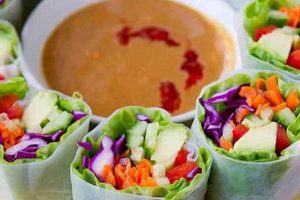The composition of Skittles, a popular fruit-flavored candy, is frequently examined by individuals adhering to plant-based diets. This scrutiny stems from the presence of ingredients historically derived from animal sources in similar confectioneries. The primary concern revolves around additives like gelatin, carmine, and shellac, which are not plant-derived. Therefore, the formulation of Skittles becomes a point of interest for consumers seeking products aligned with vegan principles.
Identifying foods suitable for a vegan lifestyle necessitates careful ingredient analysis. Many processed food items contain components that are not immediately obvious as animal-derived. Awareness of potential non-vegan ingredients allows individuals to make informed purchasing decisions. The impact of dietary choices extends beyond personal consumption, influencing food production practices and promoting greater transparency within the food industry. Historically, the awareness of these ingredients has grown with the rise of veganism and consumer demand for clearer labeling practices.
Considering the ingredients of Skittles, the following discussion will delve into specific components and their relevance to vegan dietary standards. It will explore changes in formulation over time, and variations in different regions, providing a comprehensive understanding of this particular candy’s suitability for individuals practicing veganism.
Skittles and Veganism
Navigating the confectionery landscape as a vegan requires diligent scrutiny of ingredient lists. The following guidance addresses key considerations regarding Skittles and their potential suitability within a vegan diet.
Tip 1: Always Examine the Ingredient List. Prior to consumption, meticulously review the ingredient list on the product packaging. Formulations can vary by region and production batch, making this a critical step.
Tip 2: Be Aware of Potential Formulation Changes. Manufacturers occasionally alter product ingredients. Regularly verifying the current ingredient list is essential, even if the product was previously confirmed as vegan.
Tip 3: Investigate Unclear or Ambiguous Ingredients. If an ingredient is unfamiliar or its source is uncertain, research it thoroughly. Online resources and vegan advocacy groups can provide valuable information.
Tip 4: Consider Regional Variations. Product formulations can differ significantly between countries or regions. Be mindful of the specific origin of the product and its corresponding ingredients.
Tip 5: Contact the Manufacturer for Clarification. When in doubt, contact the manufacturer directly. Customer service representatives may be able to provide specific details regarding ingredient sourcing and manufacturing processes.
Tip 6: Exercise Caution with “Natural Flavors”. The term “natural flavors” can sometimes mask animal-derived ingredients. Inquire with the manufacturer about the specific origin of these flavors to ensure compliance with vegan principles.
Adhering to these guidelines promotes informed decision-making and facilitates the selection of confectionery products that align with vegan dietary requirements. Consistent application of these principles will minimize the risk of unintentional consumption of non-vegan ingredients.
With this knowledge, the reader can now confidently determine whether Skittles, based on its current formulation, fits within their vegan dietary framework and integrate this information into a broader understanding of vegan food choices.
1. Gelatin Absence
The absence of gelatin is a critical determinant of whether Skittles conforms to vegan dietary standards. Gelatin, a protein derived from animal collagen, is commonly used as a gelling agent in various food products, including candies. Its presence automatically disqualifies a product from being considered vegan. Therefore, the formulation of Skittles must explicitly exclude gelatin to be deemed suitable for individuals adhering to a plant-based diet. Skittles’ ingredient list is often scrutinized for this absence to confirm its vegan-friendly status. For instance, consumers actively compare ingredient lists across different Skittles product lines or regions, specifically looking for the reassurance that gelatin has not been included.
The inclusion of gelatin in similar confectioneries underscores the importance of its absence in Skittles. Many gummy candies, marshmallows, and certain types of jelly beans rely on gelatin for their characteristic texture. The fact that Skittles do not use gelatin differentiates it within the candy market and makes it a potential option for vegans. However, vigilance is still required as ingredient formulations can change, and other non-vegan ingredients might be present, requiring a holistic assessment. This principle extends to practical applications such as meal planning and ethical consumerism. Vegan consumers actively promote products that avoid animal-derived ingredients, further emphasizing the significance of the gelatin-free formulation of Skittles. However, the other components of this candy product also must be free of animal products.
In summary, the absence of gelatin is a pivotal factor in determining whether Skittles aligns with vegan dietary principles. Its exclusion allows Skittles to be considered a viable option within the realm of vegan confectionery, but only if combined with the absence of other animal-derived ingredients. The ongoing scrutiny of Skittles’ ingredient list reinforces the need for consistent transparency and accurate labeling practices within the food industry to accommodate the needs of consumers with specific dietary requirements. The primary challenge remains the potential for formulation changes, necessitating continued vigilance among vegan consumers.
2. Carmine Exclusion
The absence of carmine is a pivotal factor in evaluating the suitability of Skittles for vegan consumption. Carmine, a red pigment derived from insects, is a common colorant in the food industry. Its presence invariably renders a product non-vegan. Therefore, confirmation of carmine exclusion is crucial for Skittles to align with plant-based dietary principles.
- Source of Carmine
Carmine, also known as cochineal extract, is obtained from the dried bodies of female cochineal insects. This inherently animal-derived source directly contravenes vegan dietary principles, which preclude the consumption of any animal products or byproducts. Consequently, any product utilizing carmine is unsuitable for individuals adhering to a vegan lifestyle.
- Role in Food Coloring
Carmine serves as a vibrant red food colorant. Its stability and intensity make it attractive for use in various applications, including candies, beverages, and processed foods. Its coloring properties render it a common choice for manufacturers seeking to enhance visual appeal; however, this comes at the cost of excluding vegan consumers.
- Labeling Requirements
Food labeling regulations mandate the disclosure of carmine as an ingredient, although it may appear under various names, including cochineal extract, carminic acid, or natural red 4. Consumers seeking vegan products must meticulously scrutinize ingredient lists for these terms. Accurate labeling is crucial for informed decision-making, enabling individuals to avoid non-vegan products effectively.
- Alternatives to Carmine
Vegan-friendly alternatives to carmine exist, including beet juice extract, anthocyanins from fruits and vegetables, and synthetic red dyes certified as vegan. Manufacturers seeking to cater to vegan consumers can readily replace carmine with these plant-derived or synthetically produced colorants. The utilization of such alternatives allows for the creation of visually appealing products that align with ethical dietary choices.
The significance of carmine exclusion for Skittles hinges on the manufacturer’s commitment to vegan-friendly ingredients. If Skittles are formulated without carmine and utilize vegan-compatible colorants instead, they can be considered suitable for individuals following a plant-based diet. Conversely, if carmine is present, the product is definitively non-vegan. Continuous monitoring of ingredient lists remains essential, given the potential for formulation changes over time.
3. Shellac Omission
Shellac, a resin secreted by the lac beetle, is frequently used as a glazing agent in confectionery products to impart shine and extend shelf life. Its animal origin inherently disqualifies it from vegan consideration. Therefore, the absence of shellac is a prerequisite for Skittles to be deemed suitable for a vegan diet. The omission of shellac directly impacts the product’s classification, effectively determining whether or not it aligns with the ethical and dietary requirements of vegan consumers. Without shellac omission, “skittles vegan” becomes an impossibility.
Many candies and coated tablets traditionally employ shellac to create a smooth, glossy finish. Its durable nature provides a protective barrier against moisture and physical damage. However, its animal-derived nature necessitates the utilization of plant-based alternatives to achieve similar results in vegan-friendly products. Examples of suitable alternatives include vegetable-based waxes and certain types of food-grade gums. These substitutions demonstrate a commitment to accommodating diverse dietary needs and preferences. The practical application of this understanding lies in consumers ability to confidently identify and select products that adhere to their ethical and dietary principles.
In summary, the shellac omission is a critical component in assessing the vegan status of Skittles. Its exclusion, coupled with the absence of other animal-derived ingredients, is essential for the product to align with vegan standards. While challenges may arise in achieving similar glazing effects with plant-based alternatives, the importance of catering to the growing vegan market underscores the significance of ongoing research and development in this area. Continued vigilance in ingredient scrutiny remains paramount for ensuring accurate product labeling and promoting informed consumer choices.
4. Glycerin Source
The compatibility of Skittles with a vegan diet hinges significantly on the source of glycerin, if present in the ingredient list. Glycerin, also known as glycerol, is a humectant, meaning it attracts and retains moisture, contributing to a product’s texture and shelf life. Glycerin can be derived from either animal fats or vegetable oils. If the glycerin in Skittles is animal-derived, the product is rendered non-vegan. Conversely, if it’s sourced from plants (e.g., soy, palm, or coconut oil), it can potentially align with vegan dietary requirements, contingent on the absence of other animal-derived ingredients. Transparency regarding the origin of glycerin is, therefore, crucial for vegan consumers.
Understanding the importance of glycerin’s source translates into practical applications for consumers. Vegan individuals meticulously scrutinize ingredient lists for ambiguous terms like “glycerin” or “glycerol,” which do not inherently specify the source. When uncertainty arises, contacting the manufacturer to ascertain the origin of the glycerin becomes necessary. For example, if a consumer contacts Mars Wrigley, the manufacturer of Skittles, and receives confirmation that the glycerin is derived from sustainable palm oil, this information aids in their decision-making process. This level of due diligence ensures adherence to personal dietary principles. Furthermore, consumer demand for clarity regarding ingredient sourcing influences manufacturers to provide more detailed information, ultimately promoting transparency within the food industry.
In summary, the glycerin source is a critical determinant of whether Skittles meets vegan standards. Without explicit confirmation of a plant-based origin, Skittles cannot be unequivocally classified as vegan. The responsibility lies with both manufacturers to provide transparent ingredient information and with consumers to actively seek clarification when ambiguity exists. This focus on glycerin source exemplifies the broader challenges associated with navigating ingredient lists and ensuring that food choices align with specific dietary requirements. The “skittles vegan” status relies on consistent transparency and accurate ingredient information.
5. Natural Flavors
The presence of “natural flavors” in Skittles’ ingredient list introduces a degree of ambiguity when assessing its suitability for vegan consumption. While the term suggests ingredients derived from natural sources, it provides limited information about the specific origin of those sources. The regulatory definition of “natural flavor” permits the inclusion of substances extracted from plants or animals, provided the primary function is flavoring, not nutritional. This lack of specificity necessitates further investigation to determine if the “natural flavors” in Skittles are exclusively plant-based. The implication for the “skittles vegan” question is significant: the product can only be considered vegan if these flavors originate from plant sources.
Determining the vegan status of “natural flavors” often requires direct communication with the manufacturer. Consumers may need to contact Mars Wrigley to inquire about the precise source of the flavoring components. For instance, a consumer might ask if any dairy-derived ingredients, such as lactose or whey, are used in the “natural flavors” blend. Alternatively, they may inquire about the use of flavor enhancers derived from animal products. The response from the manufacturer dictates whether the specific Skittles product adheres to vegan dietary principles. If the manufacturer confirms a plant-based origin, the presence of “natural flavors” presents no conflict. However, the absence of clear clarification leaves the consumer with uncertainty, prompting some to avoid the product altogether.
In conclusion, “natural flavors” represent a potential impediment to definitively classifying Skittles as vegan. The lack of transparency inherent in the term necessitates proactive inquiry to ensure compliance with vegan dietary standards. While the ingredient list may appear vegan-friendly on the surface, the ambiguity surrounding “natural flavors” underscores the importance of critical evaluation and direct engagement with food manufacturers to resolve uncertainties. The “skittles vegan” question remains contingent upon the definitive plant-based sourcing of its “natural flavors.”
6. Regional Variations
The suitability of Skittles for a vegan diet is not universally consistent, as regional variations in ingredient formulations can significantly impact its compliance with plant-based principles. This necessitates careful examination of the specific product labeling at the point of purchase.
- Ingredient Sourcing
Ingredient sourcing can differ significantly between manufacturing locations. A specific ingredient, such as glycerin or a particular flavoring agent, may be derived from plant sources in one region but from animal sources in another. This discrepancy directly affects the vegan status of the product, requiring consumers to verify the ingredient list specific to their geographic location. For instance, Skittles manufactured in the European Union may adhere to different standards compared to those produced in the United States, leading to variations in ingredient composition.
- Regulatory Compliance
Varying regulatory requirements across different countries influence ingredient usage. Certain additives or colorants permitted in one region may be restricted or prohibited in another. These regulatory differences necessitate adjustments in product formulations to comply with local regulations. Consequently, the presence or absence of specific ingredients, such as carmine or shellac, can vary, impacting the overall vegan compatibility of Skittles depending on the region where it is sold. Local food safety standards play a key role in determining what can be legally included in the recipe.
- Manufacturing Processes
Even with similar ingredient lists, subtle variations in manufacturing processes can introduce non-vegan elements. For example, the use of equipment that also processes animal-derived products may lead to cross-contamination, rendering the final product unsuitable for strict vegans. The cleaning agents employed or the coatings applied to machinery can also introduce discrepancies based on regional practices. These less obvious factors further complicate the assessment of Skittles’ vegan status and emphasize the importance of contacting the manufacturer for detailed information regarding production practices.
- Consumer Preferences
Regional consumer preferences influence product formulations. A flavor popular in one region may not be as well-received in another, prompting manufacturers to adjust ingredient profiles accordingly. These adjustments can inadvertently introduce or remove animal-derived components, thereby affecting the product’s suitability for vegan consumers. For example, a specific natural flavor may be replaced with a more cost-effective alternative that is not plant-based, leading to regional disparities in the vegan compatibility of Skittles.
These regional variations underscore the need for diligence and caution when evaluating the vegan status of Skittles. Consumers must remain vigilant in scrutinizing ingredient labels and contacting manufacturers for clarification, particularly when purchasing products in different regions or while traveling. The “skittles vegan” designation, therefore, is not a universal truth but rather a context-dependent assessment that relies on specific regional product characteristics.
Frequently Asked Questions
This section addresses common inquiries regarding the compatibility of Skittles with vegan dietary principles, providing factual information to aid informed consumer choices.
Question 1: Are all Skittles flavors vegan?
The vegan status of Skittles can vary depending on the specific flavor and the region of production. Ingredient formulations are not universally consistent. Therefore, verifying the ingredient list on each package is essential.
Question 2: What non-vegan ingredients might be present in Skittles?
Potential non-vegan ingredients include gelatin (derived from animal collagen), carmine (a red pigment from insects), shellac (a resin from lac beetles), and glycerin (which can be sourced from either plant or animal fats). Additionally, the catch-all term “natural flavors” can sometimes mask animal-derived components.
Question 3: How can the source of ambiguous ingredients like “natural flavors” be determined?
The most reliable method is to contact the manufacturer directly and inquire about the specific source of these ingredients. Customer service representatives may provide detailed information regarding ingredient origins and manufacturing processes.
Question 4: Do manufacturing processes affect the vegan status of Skittles?
Yes, manufacturing processes can affect the vegan status. Cross-contamination with animal-derived products during production is possible if equipment is shared. While ingredient lists may appear vegan, these cross-contamination risks exist.
Question 5: Can the ingredient list change over time?
Manufacturers occasionally alter product formulations. The ingredient list should be verified each time a purchase is made, even if the product was previously confirmed as vegan.
Question 6: Is the absence of a “vegan” label a definitive sign that Skittles are not vegan?
The absence of a “vegan” label does not definitively indicate that Skittles are non-vegan. Some manufacturers do not pursue vegan certification, even if the product technically meets vegan standards. Diligent ingredient list evaluation is still necessary.
In summary, determining whether Skittles aligns with vegan requirements necessitates meticulous ingredient scrutiny, awareness of regional variations, and, when necessary, direct communication with the manufacturer. A proactive and informed approach is crucial.
The next section will examine related products and their vegan compatibility.
Conclusion
The exploration of “skittles vegan” reveals a nuanced landscape requiring careful consideration. Definitive categorization necessitates meticulous ingredient list examination, awareness of regional formulation variations, and direct manufacturer inquiry when ambiguities arise. The presence of ingredients like gelatin, carmine, shellac, and the potential for animal-derived glycerin or undisclosed components within “natural flavors” demand constant vigilance. The absence of a certified vegan label does not guarantee or preclude suitability.
The ultimate determination of whether Skittles aligns with individual vegan principles rests upon the consumer’s commitment to informed decision-making. The onus remains on the individual to verify product specifics, contributing to a more transparent and ethically conscious food system. Continued scrutiny and proactive engagement with manufacturers are essential to navigate the complexities of ingredient sourcing and ensure dietary choices reflect personal values. The future of clearly labeled and reliably vegan confectionery depends on sustained consumer demand and industry responsiveness.







